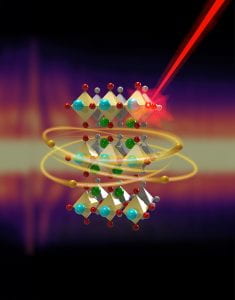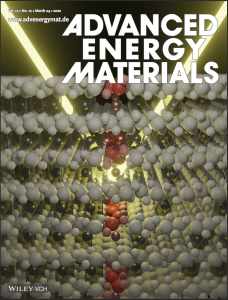New paper by Jason published in Nature Catalysis and featured in the Cornell Chronicle
Cornell Chronicle Feature on Multimodal in situ X-ray mechanistic studies of a bimetallic oxide electrocatalyst in alkaline media by Jason in Nature Catalysis.
 Abstract:
Abstract:New paper by Anita published in Nature Physics and featured in the Cornell Chronicle
Cornell Chronicle Feature on Picosecond volume expansion drives a later-time insulator–metal transition in a nano-textured Mott insulator by Anita in Nature Physics.
 Abstract:
Abstract:New paper by Ziming published in Proceedings of the National Academy of Sciences and featured by the Cornell Chronicle
Cornell Chronicle Feature on Real-space imaging of periodic nanotextures in thin films via phasing of diffraction data by Ziming in Proceedings of the National Academy of Sciences.
Abstract:
New properties and exotic quantum phenomena can form due to periodic nanotextures, including Moire patterns, ferroic domains, and topologically protected magnetization and polarization textures. Despite the availability of powerful tools to characterize the atomic crystal structure, the visualization of nanoscale strain-modulated structural motifs remains challenging. Here, we develop nondestructive real-space imaging of periodic lattice distortions in thin epitaxial films and report an emergent periodic nanotexture in a Mott insulator. Specifically, we combine iterative phase retrieval with unsupervised machine learning to invert the diffuse scattering pattern from conventional X-ray reciprocal-space maps into real-space images of crystalline displacements. Our imaging in PbTiO3/SrTiO3 superlattices exhibiting checkerboard strain modulation substantiates published phase-field model calculations. Furthermore, the imaging of biaxially strained Mott insulator Ca2RuO4 reveals a strain-induced nanotexture comprised of nanometer-thin metallic-structure wires separated by nanometer-thin Mott-insulating-structure walls, as confirmed by cryogenic scanning transmission electron microscopy (cryo-STEM). The nanotexture in Ca2RuO4 film is induced by the metal-to-insulator transition and has not been reported in bulk crystals. We expect the phasing of diffuse X-ray scattering from thin crystalline films in combination with cryo-STEM to open a powerful avenue for discovering, visualizing, and quantifying the periodic strain-modulated structures in quantum materials.
Jiaruo’s paper published in Nature Communications Physics
Phonon-assisted formation of an itinerant electronic density wave by Jiaruo in Nature Communications Physics
Abstract:
Electronic instabilities drive ordering transitions in condensed matter. Despite many advances in the microscopic understanding of the ordered states, a more nuanced and profound question often remains unanswered: how do the collective excitations influence the electronic order formation? Here, we experimentally show that a phonon affects the spin density wave (SDW) formation after an SDW-quench by femtosecond laser pulses. In a thin film, the temperature-dependent SDW period is quantized, allowing us to track the out-of-equilibrium formation path of the SDW precisely. By exploiting its persistent coupling to the lattice, we probe the SDW through the transient lattice distortion, measured by femtosecond X-ray diffraction. We find that within 500 femtoseconds after a complete quench, the SDW forms with the low-temperature period, directly bypassing a thermal state with the high-temperature period. We argue that a wavevector-matched phonon launched by the quench changes the formation path of the SDW through the dynamic pinning of the order parameter.
New paper by Jason published in Advanced Energy Materials and featured by the Cornell Chronicle

Cornell Chronicle Feature on Disorder Dynamics in Battery Nanoparticles During Phase Transitions Revealed by Operando Single-Particle Diffraction by Jason in Advanced Energy Materials
Abstract:
Structural and ion-ordering phase transitions limit the viability of sodium-ion intercalation materials in grid scale battery storage by reducing their lifetime. However, the combination of phenomena in nanoparticulate electrodes creates complex behavior that is difficult to investigate, especially on the single-nanoparticle scale under operating conditions. In this work, operando single-particle X-ray diffraction (oSP-XRD) is used to observe single-particle rotation, interlayer spacing, and layer misorientation in a functional sodium-ion battery. oSP-XRD is applied to Na2/3Ni1/3Mn2/3O2, an archetypal P2-type sodium-ion-positive electrode material with the notorious P2-O2 phase transition induced by sodium (de)intercalation. It is found that during sodium extraction, the misorientation of crystalline layers inside individual particles increases before the layers suddenly align just prior to the P2-O2 transition. The increase in the long-range order coincides with an additional voltage plateau signifying a phase transition prior to the P2-O2 transition. To explain the layer alignment, a model for the phase evolution is proposed that includes a transition from localized to correlated Jahn–Teller distortions. The model is anticipated to guide further characterization and engineering of sodium-ion intercalation materials with P2-O2 type transitions. oSP-XRD, therefore, opens a powerful avenue for revealing complex phase behavior in heterogeneous nanoparticulate systems.
New paper by Dan published in ACS Energy Letters and featured by the Cornell Chronicle
Cornell Chronicle Feature on Structure-Selective Operando X-ray Spectroscopy by Dan in ACS Energy Letters
Abstract:
The relationship between charge transport and structural transformations dictates the properties of electrochemical systems. Despite their importance, the reduction–oxidation (redox) reactions within dynamically coexisting structures have so far eluded direct operando investigation. Here, we use resonant X-ray scattering to select X-ray spectra of a crystal structure coexisting with a different structure during a redox-induced phase transformation in P2-Na2/3Ni1/3Mn2/3O2. The spectra of the P2 structure become static midway through the sodium extraction in an operando coin cell, while the overall desodiation proceeds. The coincident emergence of the O2 structure reveals the rigid link between the local redox and the long-range order in this archetypal sodium-ion battery material. Structure-selective X-ray spectroscopy thus opens a powerful avenue for resolving the dynamic chemistry of different structural phases in multistructure electrochemical systems.
New Nature Communications paper by Oleg was featured by the Cornell Chronicle
Cornell Chronicle Feature on Femtosecond control of phonon dynamics near a magnetic order critical point by Oleg in Nature Communications
Abstract:
The spin-phonon interaction in spin density wave (SDW) systems often determines the free energy landscape that drives the evolution of the system. When a passing energy flux, such as photoexcitation, drives a crystalline system far from equilibrium, the resulting lattice displacement generates transient vibrational states. Manipulating intermediate vibrational states in the vicinity of the critical point, where the SDW order parameter changes dramatically, would then allow dynamical control over functional properties. Here we combine double photoexcitation with an X-ray free-electron laser (XFEL) probe to control and detect the lifetime and magnitude of the intermediate vibrational state near the critical point of the SDW in chromium. We apply Landau theory to identify the mechanism of control as a repeated partial quench and sub picosecond recovery of the SDW. Our results showcase the capabilities to influence and monitor quantum states by combining multiple optical photoexcitations with an XFEL probe. They open new avenues for manipulating and researching the behaviour of photoexcited states in charge and spin order systems near the critical point.
New paper by Yifei is now published on Nano Letters and was featured by Cornell Chronicle and APS Science Highlights

Features:
Cornell Chronicle
APS Science Highlights
Abstract:
All-solid-state lithium batteries promise significant improvements in energy density and safety over traditional liquid electrolyte batteries. The Al-doped Li7La3Zr2O12 (LLZO) solid-state electrolyte shows excellent potential given its high ionic conductivity and good thermal, chemical, and electrochemical stability. Nevertheless, further improvements on electrochemical and mechanical properties of LLZO call for an in-depth understanding of its local microstructure. Here, we employ Bragg coherent diffractive imaging to investigate the atomic displacements inside single grains of LLZO with various Al-doping concentrations, resulting in cubic, tetragonal, and cubic–tetragonal mixed structures. We observe coexisting domains of different crystallographic orientations in the tetragonal structure. We further show that Al doping leads to crystal defects such as dislocations and phase boundaries in the mixed- and cubic-phase grain. This study addresses the effect of Al doping on the nanoscale structure within individual grains of LLZO, which is informative for the future development of solid-state batteries.
Read the full paper here.
New paper on an algorithm for Bragg coherent x-ray diffractive imaging of highly strained nanocrystals by Ziyi and Oleg
By using phase retrieval, Bragg coherent diffractive imaging (BCDI) allows tracking of three-dimensional displacement fields inside individual nanocrystals. Nevertheless, during structural phase transformations, significant strains (1% and higher) are common, and BCDI fails due to the Bragg peak distortions. Here we present and advanced BCDI algorithm enabling imaging three-dimensional strain fields in highly strained crystals with separated structural phases. We test the algorithm on particles simulated to undergo a structural phase transformation. While the conventional algorithms fail in unambiguously reconstructing the phase morphology, our algorithm correctly retrieves the morphology of coexistent phases with a strain difference of 1%. The key novelty is the simultaneous reconstruction of multiple scans of the same nanoparticle at snapshots through the phase transformations. The algorithm enables visualizing phase transformations in nanoparticles of lithium-ion, sodium-ion nanoparticles, and other nanoparticulate materials in working conditions (operando).
Read the full paper here: DOI 10.1088/1367-2630/ab61db
